Icanvas the Music Hall Gallery Wrapped Canvas Art Print by Eric Fan
Truly iconic album covers don't merely define an album, they define an era, a generation, and, in some cases, an entire musical genre. Sometimes they do all three: what is The Beatles' Sgt Pepper's Lonely Hearts Lodge album comprehend, if not the ultimate manifestation of 60s psychedelia for the "peace and honey" oversupply?
Sometimes album covers are helped on their mode to iconic status because of the musicians they feature: photogenic stars, such every bit Elvis Presley, David Bowie, or Prince, whose godlike images are burned into our retinas. Other iconic album covers are envisioned by creative masterminds. The business firm Hipgnosis defined the 70s with their many optical illusions. Peter Saville made Manufacturing plant Records a sensation with the radio waves of Joy Partition's Unknown Pleasures (and many more than). Andy Warhol, meanwhile, dreamed upwardly The Rolling Stones' iconic blue jeans crotch and zipper on Pasty Fingers. The best album covers come across these graphic designs featherbed linear thinking and emerge with an image that is a bona fide piece of work of art in its own right.
While art might be a affair of taste, lasting legacy is something that's more than easily measured. Our listing of the 25 about iconic album covers of all time may non be exhaustive, but it certainly reveals why anthology covers deserve to be held in as high a regard as more than traditional modes of artwork.
While y'all're reading, listen to our Greatest Anthology Covers playlist here.
Elvis Presley: Elvis Presley (1956)
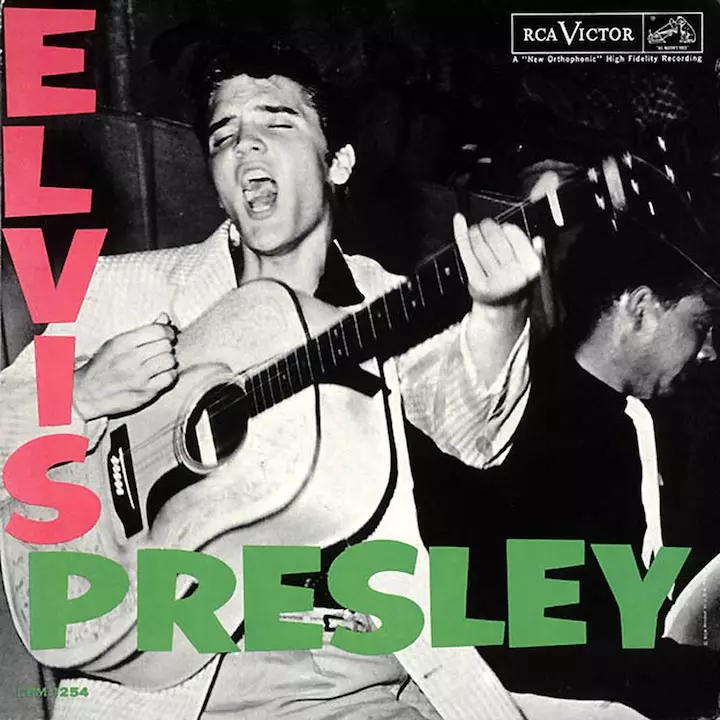
Ii simple words: "Elvis" and "Presley" (the latter barely hiding that controversial pelvis from view): that's all information technology needed to say. Caught playing the guitar and singing during a performance at the Fort Homer Hesterly Armory, Tampa, Florida, on July 31, 1955, yous can still feel the primal rock'n'roll energy from a young man set to take over the world. Two decades afterward, The Clash and photographer Pennie Smith felt there was nonetheless none more rock'n'roll, and nicked the idea for the epochal London Calling vinyl album embrace.
The Beatles: Sgt Pepper's Solitary Hearts Club Band (1967)
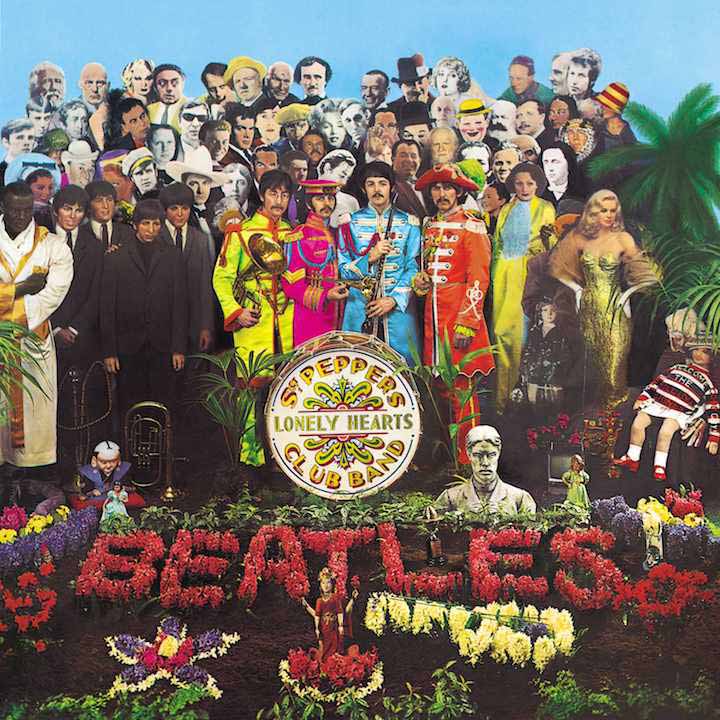
The Beatles, of course, had enough of iconic album covers in their career, including Abbey Road and The White Anthology. But the most important and, at the time the most expensive album embrace ever made, the Sgt. Pepper album comprehend remains a popular art masterpiece that has influenced anybody from Frank Zappa (We're Only In It For The Money) to The Simpsons (The Yellow Album). Staged past British artist Peter Blake and his then-wife, Jann Haworth, the Sgt Pepper album embrace depicted 58 unlike people, called by John Lennon, Paul McCartney, George Harrison, Peter Blake, Jann Haworth and London fine art dealer Robert Fraser, presenting a fascinating cantankerous-section of cultures, importance, and each Beatle'south private interests like Marlon Brando, Karl Marx, and Marilyn Monroe.
Click here for an interactive Sgt Pepper comprehend to discover who's who on one of the most important anthology covers of all time.
The Velvet Underground & Nico: The Velvet Underground & Nico (1967)
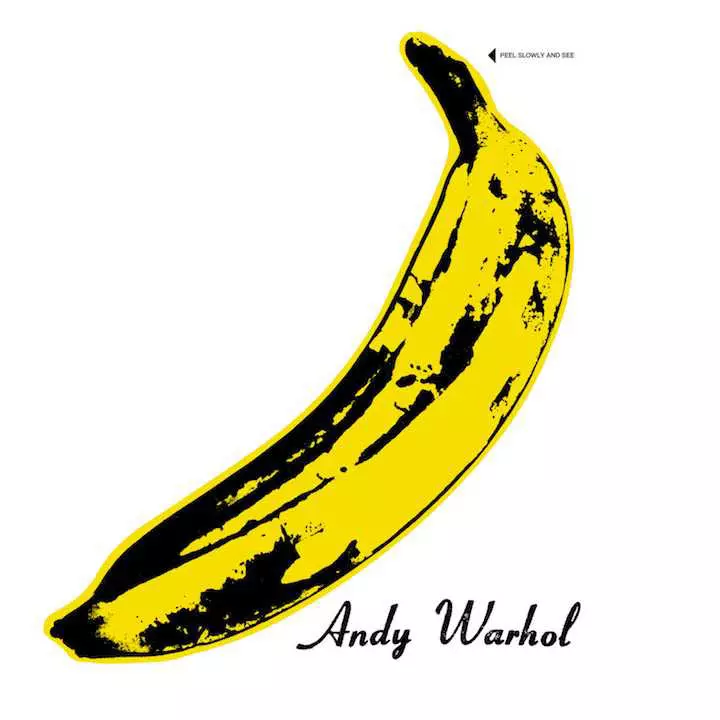
If Peter Blake's Sgt Pepper album comprehend is the virtually famous case of British pop art, and so Andy Warhol's design for The Velvet Surreptitious's debut, released that same year, remains one of the most famous from the US. Information technology's "Peel Slowly And See" banana peel was really a sticker that revealed the phallic fruit beneath – a typically wry motion from Warhol, though the joke was on anyone who removed the sticker. Fully intact copies of the VU'south debut anthology are now hugely collectible rarities.
Frank Zappa/The Mothers Of Invention: Weasels Ripped My Flesh (1970)
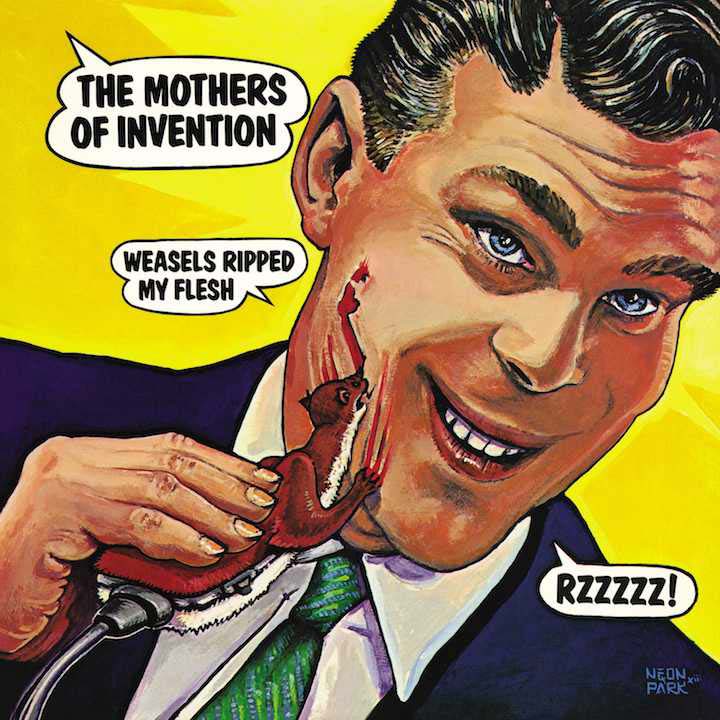
Likewise as creating artwork for nearly every Petty Feat album, illustrator Neon Park'southward distinctive way was put to unforgettable effect on a collection of Mothers material recorded from 1967-69. Having come beyond the September 1956 edition of Man'south Life, an adventure mag whose cover pictured a man being attacked by weasels, Zappa took the "Weasels Ripped My Flesh" caption for a title and challenged Parks to make something "worse than this". The result: a gruesome spoof advert for an electric razor.
Roxy Music: Roxy Music (1972)
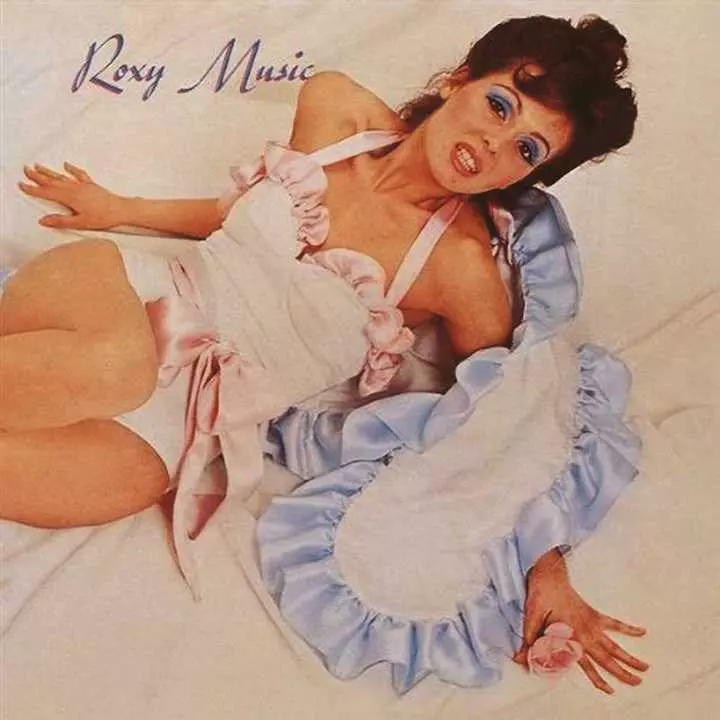
While many of the most memorable album covers of the early 70s were high-concept artworks designed past the likes of Hipgnosis or Roger Dean, Roxy Music'south approach was startlingly simple: glamorous imagery, more like a 50s fashion shoot than an anthology cover. Often romantically linked with frontman Bryan Ferry, each model had their intriguing own back story. Having appeared as a Bail girl in On Her Majesty'south Secret Service, Kari-Ann Muller featured on the front of Roxy Music for the sum of merely £xx. Latterly a yoga teacher, she went on to marry Chris Jagger, whose brother has an interesting tale of his ain…
Pinkish Floyd: The Dark Side Of The Moon (1973)
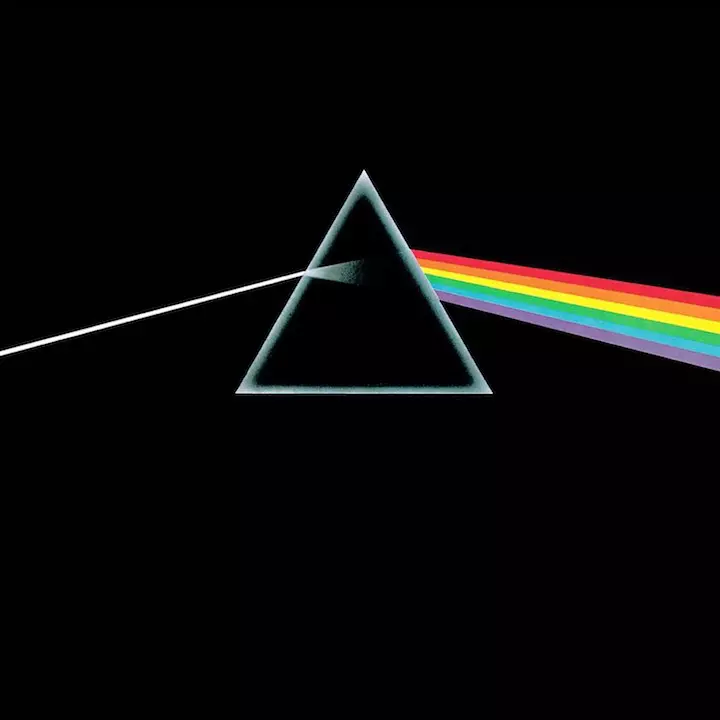
One of the well-nigh iconic album covers of all time, created past ane of the well-nigh iconic design teams of all time. Hipgnosis' master men, Storm Thorgerson and Aubrey Powell, came up with the concept for The Dark Side Of The Moon , while their colleague George Hardie executed it: a prism refracting light into half-dozen of the 7 the colours of the spectrum (indigo is missing). The triumvirate of light beam, prism and spectrum apparently stood for three aspects of the band and their music: ambitious stage lighting, Nighttime Side's lyrics and keyboardist Richard Wright's asking that Hipgnosis create something assuming even so simple. Job washed, then.
David Bowie: Aladdin Sane (1973)
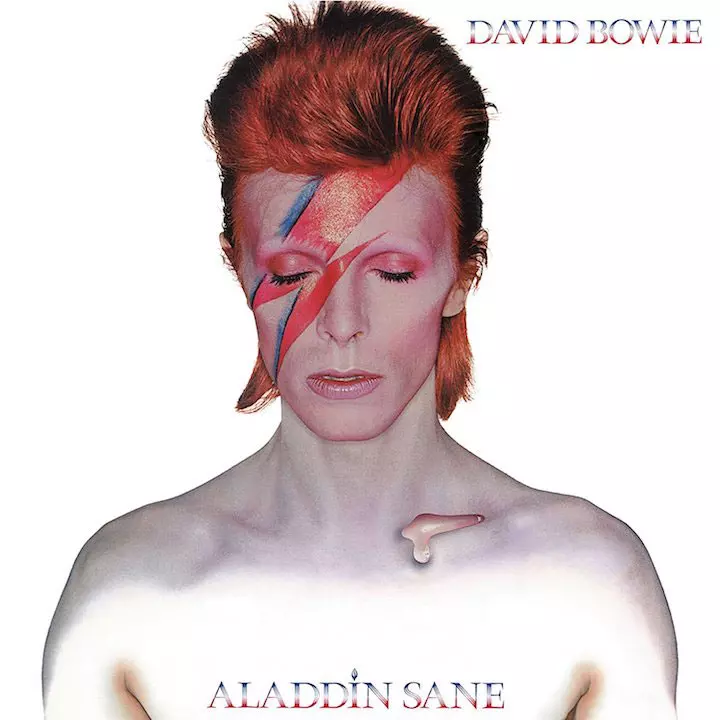
Brian Duffy's portrait remains the image most associated with David Bowie: his Aladdin Sane persona an extension of Ziggy Stardust; the lightning bolt a representation of the "cracked actor" that Bowie felt he had get during his sudden ascension to superstardom. Yet while Bowie exuded otherworldly powers at this indicate in his career, the cover photo was taken in the very earthly confines of Brian Duffy'due south studio in Primrose Hill, London. The teardrop on Bowie'southward clavicle was an addition of Duffy's later on the shoot: a perfect touch that makes Bowie seem both mysterious and tender at the aforementioned fourth dimension.
Led Zeppelin: Houses Of The Holy (1973)
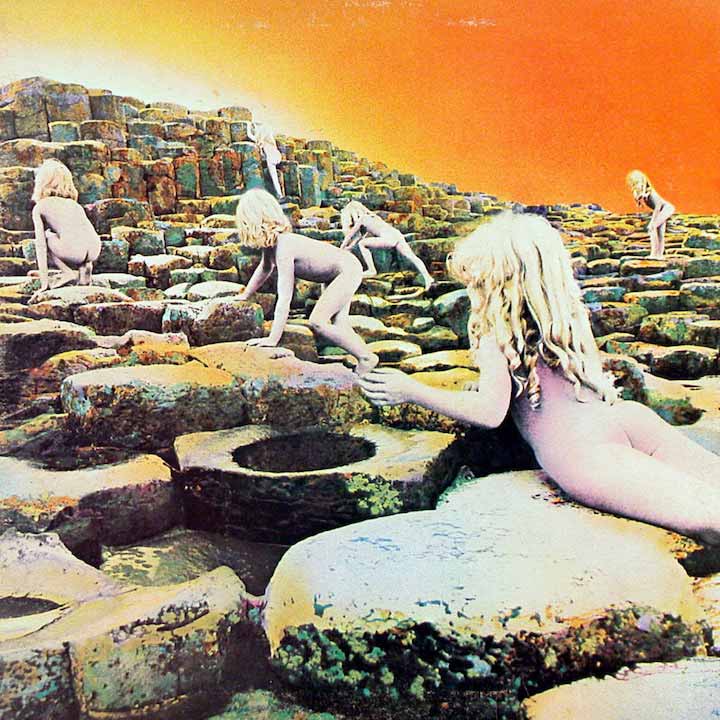
Another ane of Hipgnosis' arresting album covers, the artwork for Houses Of The Holy was inspired by the ending of Babyhood's End, a 30s sci-fi novel by author Arthur C Clarke. A collage pieced together from several photos of two children scaling Giant'south Causeway in Northern Ireland, taken over a ten-day menstruum, the artwork's eerie colouring was an accidental effect that gave the image a suitably otherworldly feel. Some other unintended after-consequence: some stores found the naked children too controversial and refused to stock the record.
Fleetwood Mac: Rumours (1977)
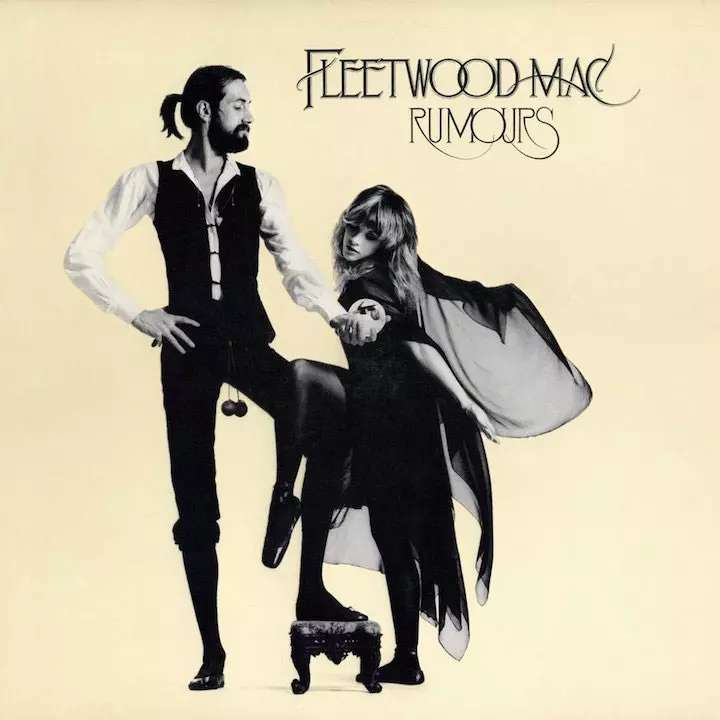
At a glance, the artwork for Fleetwood Mac'south best-selling album is simple: drummer Mick Fleetwood working upwardly some theatrics with the none-more than-melodramatic Stevie Nicks channelling the Rhiannon muse that consumed her for a menses in the mid-70s. Oh, and so you see the nod to his manhood dangling proudly betwixt his legs. Not only a schoolboy prank in the spur of the moment, the balls were really toilet chains that Mick pulled from a cistern and placed between his legs before performing one of the band's earliest gigs – and there they would remain for future alive performances, presumably dangling dangerously close to the drummer'due south tom-toms.
Prince: Imperial Rain (1984)
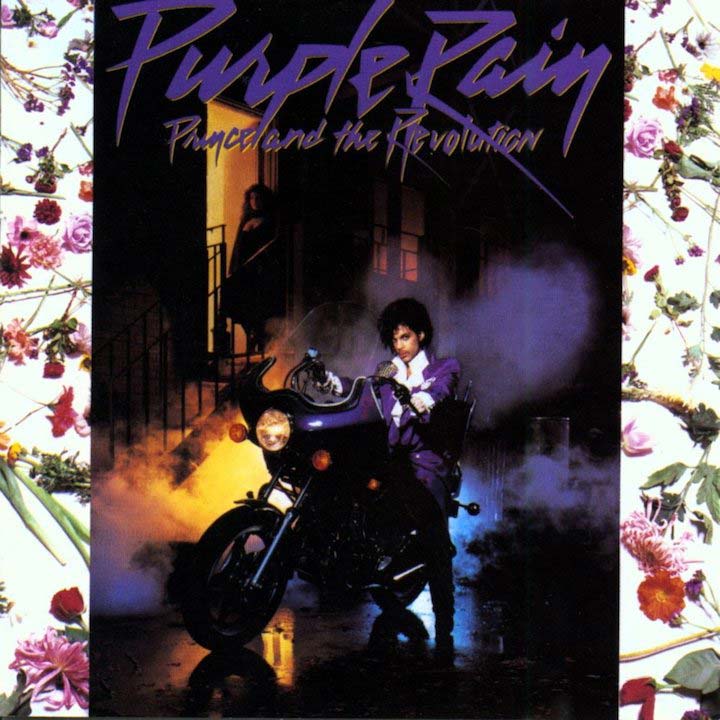
An unavoidable epitome (and album) from the mid-80s through the rest of the decade, Purple Rain introduced the world to Prince as an enigmatic presence ready to disappear at will into the dark, all Fiddling Richard pompadour and wry smile, as if in on a joke that no one else could ever hope to understand. Photographer Ed Thrasher had previously snapped the similarly flamboyant Jimi Hendrix on a motorbike (a shot that graced the posthumous compilation album South Saturn Delta), while, if y'all look closely at the bike, yous'll run across the androgyny symbol that would later on find echoes in the "Love Symbol" that Prince changed his name to.
Bruce Springsteen: Built-in In The United states (1984)
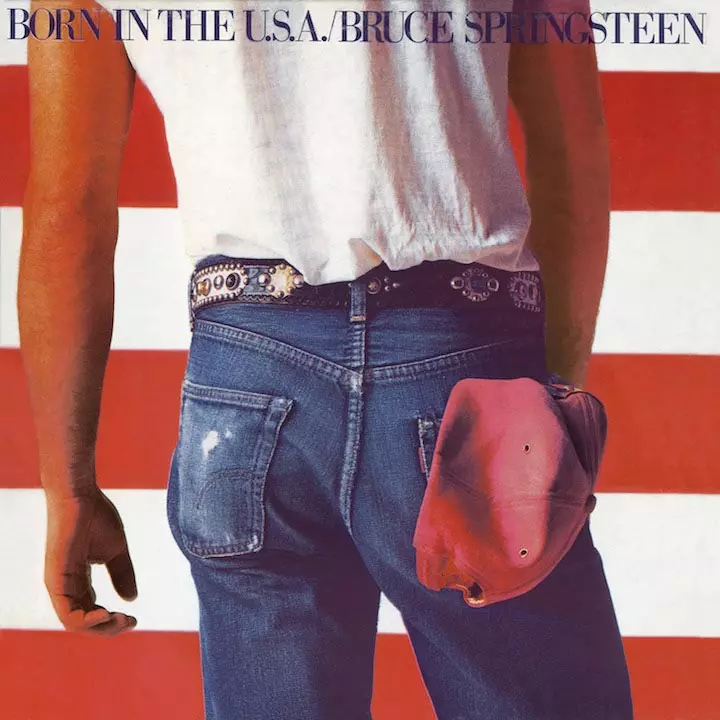
Inspired past Born In The USA'due south championship track, Rolling Stone photographer Annie Leibovitz shot Springsteen in red, white and blue, before a backdrop of the American flag, creating the ultimate American lowest photo for the ultimate American everyman album. However, similar the anthology'southward title rails – which has been open to political misinterpretation over the years – the artwork drew some negative connotations. Some idea The Dominate was relieving himself on the flag – an unintentional outcome of Springsteen choosing, from a number of photos, "the picture of my ass" because it "looked improve than the picture of my face".
Grace Jones: Isle Life (1985)
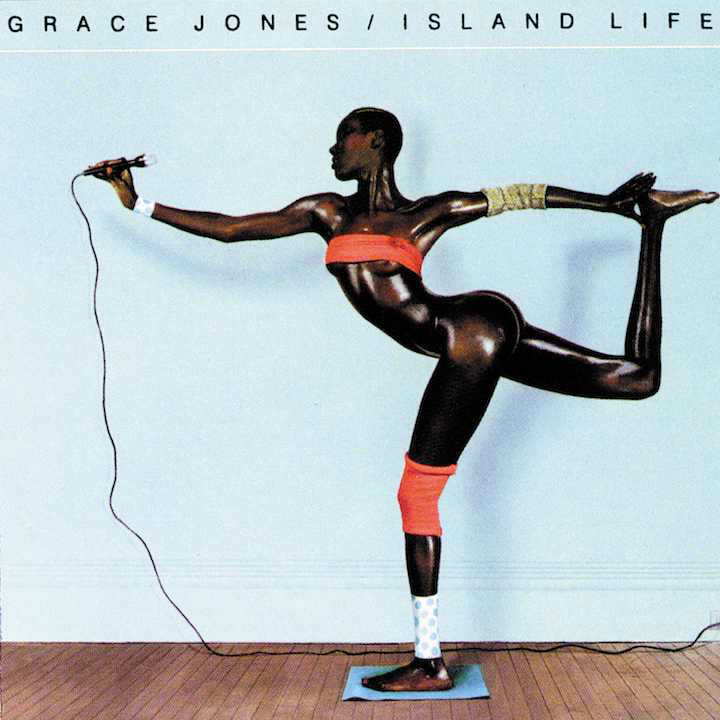
As a model, actress, and songwriter, Grace Jones' career is littered with iconic photo shoots, from downtown disco snaps to uptown magazine spreads and, of course, a great album cover or 2. While almost all of her tape sleeves qualify for "iconic" status, the 1985 collection Isle Life remains arguably her most famous. Originally printed in a 1978 edition of New York Magazine, the image was created by Jones' so partner, designer and lensman Jean-Paul Goode, who fashioned Jones' implausible posture from a composite of several photographs.
The Smiths: Meat Is Murder (1985)
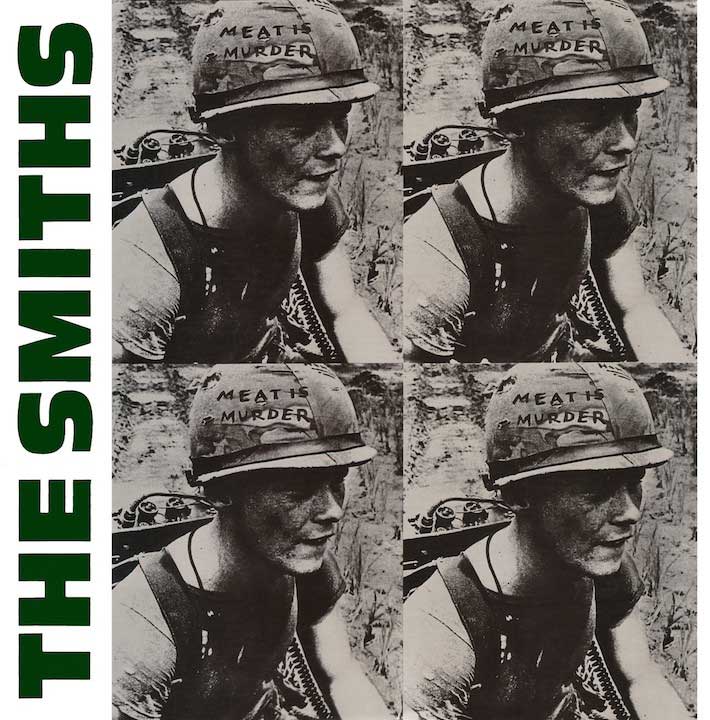
The Smiths were ever handy with an heart-communicable prototype – taken together, their album covers corporeality to a gallery of blackness-and-white images with histories as compelling as Morrissey's lyrics. For Meat Is Murder, the devoutly vegan Morrissey sought to depict a parallel betwixt meat-eating and warfare, picking a controversial epitome of a Vietnam War soldier whose helmet had been emblazoned with the album's championship. Not that the original photograph bore the "meat is murder" slogan. The 20-year-sometime Marine Corporal Michael Wynn, pictured on the album encompass, had been photographed on 21 September 1967 in Da Nang, South Vietnam, during Operation Ballistic Charge – and the slogan he'd actually written on his own helmet turned a countercultural catchphrase on its head with the hippie-baiting "make war non beloved".
NWA: Direct Outta Compton (1988)
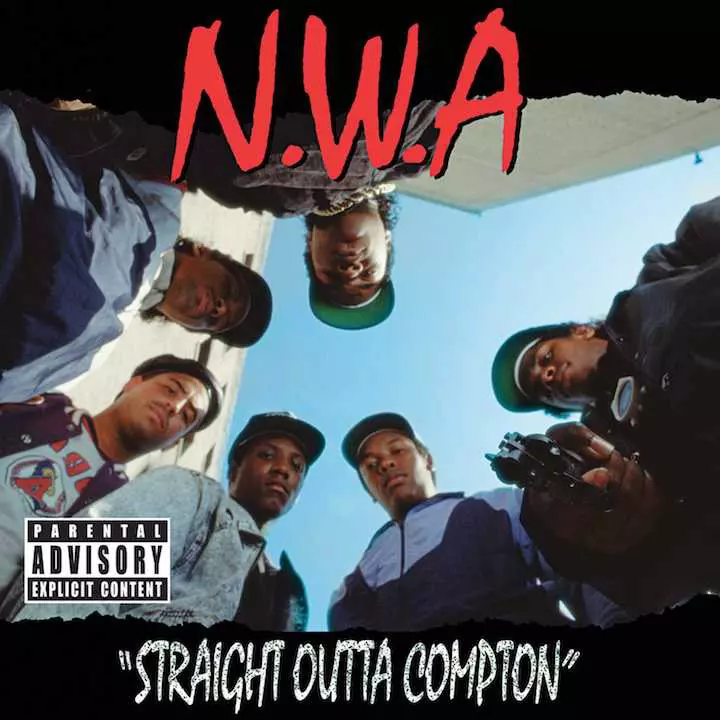
From sound to lyrical content and imagery, Straight Outta Compton defined the emerging gangsta rap genre, and its artwork has gone down in history. Speaking to CNN years after, photographer Eric Poppleton, and so just out of academy, put the paradigm's impact downward to the fact that, "Y'all're taking the perspective of someone who is about to be killed… We don't even print that stuff in newspapers." Poppleton however doesn't know if Eazy-Due east's gun was loaded – though it was certainly existent ("There wasn't annihilation fake back then," he told NME), brandished past Eazy while Poppleton and the group – with sometime sixth fellow member, producer Arabian Prince, in tow – ducked down an alleyway to capture the shot on the fly.
Nirvana: Nevermind (1991)
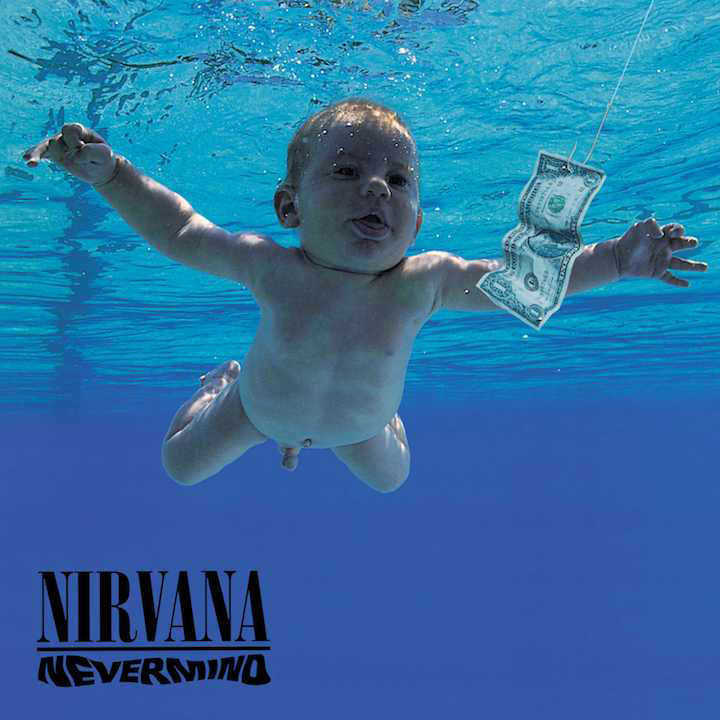
The controversial cover of Nevermind was interpreted by many every bit an innocent band reaching for the omnipotent dollar when in reality (according to Geffen Records art managing director Robert Fisher) it was the result of Kurt Cobain's fascination with a documentary on water births. Conspicuously his involvement in maternal themes would crop up again for the band'southward follow-upwardly, In Utereo. While the characterization pushed for a cover sans baby anatomy, Cobain'southward proposed compromise was a sticker covering that would read, "If you're offended past this, you must be a closet pedophile." The cover pattern has inspired endless satires.
A Tribe Called Quest: The Depression End Theory (1991)
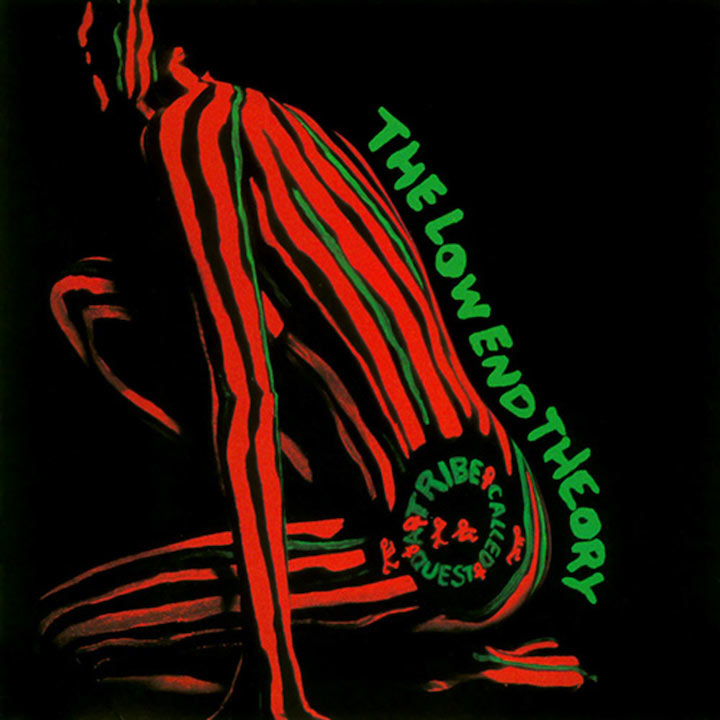
While rock music is littered with logos, the Queens rap collective A Tribe Called Quest inadvertently created one of the most recognizable symbols in hip-hop with the cover of their jazz-rap fusion masterpiece, The Low End Theory. Inspired by the provocative covers of one-time Ohio Players albums, it featured a nude model bedecked in DayGlo torso paint that is at once alluring and Afrocentric at the same fourth dimension. The bold colors and funky imagery lent itself to Tribe's creative vision on what would become their breakout album. The painted lady would later appear on subsequent Tribe releases and surely inspired the equally provocative Stankonia album art.
Dark-green Day: Dookie (1994)

Illustrated anthology covers had been around for decades by 1994, simply when it came to conjuring upwards cover fine art for Green Day's major characterization debut, artist Richie Bucher created a comic book mode globe that reflected the Bay Surface area punk scene the ring was birthed from. Part Mad Magazine-fashion fold-in and Where's Waldo? for the 90s alternative scene, you lot don't demand a magic decoder ring to spot the various Easter Eggs hidden under the spray of dookie: from Air-conditioning/DC'southward Angus Young to Large Star's Alex Chilton, Patti Smith, the University Of California Marching Ring and elements of Ramones' Rocket To Russia cover art, it's a real Who's Who of Oakland's Telegraph Artery.
Weezer: Weezer (aka "Blue Album") (1994)
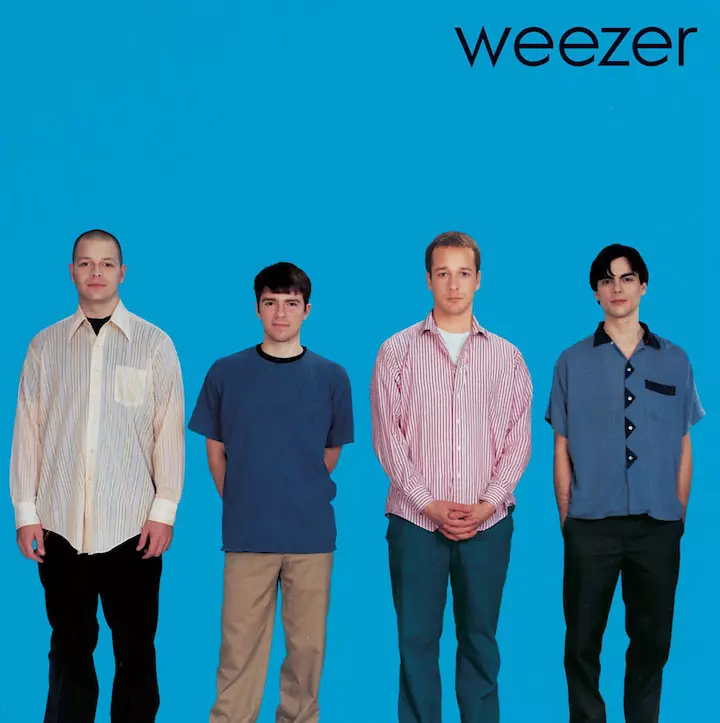
Either Weezer has a slavish devotion to monochromatic colour schemes or Rivers Cuomo has synaesthesia; either mode, since releasing their iconic "Blueish Anthology" in 1994, their discography represents a rainbow of releases that includes their "Green" (2001), "Red" (2008), and "White" albums (2016). While many early 90s releases experimented with artistic imagery, Weezer's aesthetic was decidedly more "60s Sears family photo", according to former Geffen A&R man Todd Sullivan. Later on the album's release, many pointed out its similarity to The Feelies' cover for Crazy Rhythms, when in reality, Cuomo was aiming for the clear-cut male child band image of The Beach Boys. As a result, Weezer not only had an iconic cover on their hands, only predicted the normcore motion.
The Corking Pumpkins: Mellon Collie And The Infinite Sadness (1995)
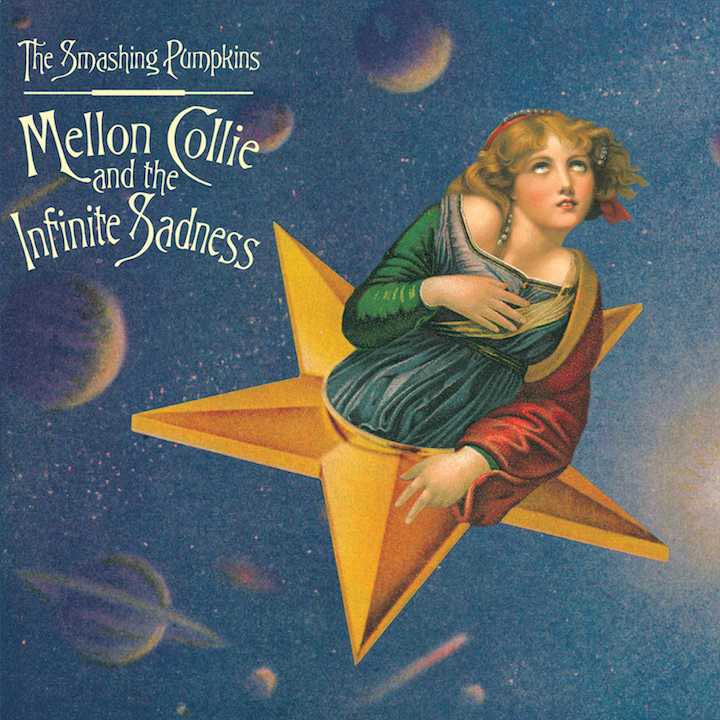
Immediately recognizable, the dreamy, Victorian-esque embrace of The Peachy Pumpkins' landmark 1995 album captures a woman in perpetual eye-roll, or a expect of ecstasy that she's held onto for over xx years. Information technology perfectly summarises the aimlessness youth to which Corgan was preaching, and the fanciful imagery matches the thou ambitions of the sprawling, 28-track album. From just a series of crude, faxed sketches, illustrator John Craig (former designer for Mercury Records and the man behind some of Rod Stewart'south most iconic sleeves) created a composite prototype using a celestial background from an quondam children'southward encyclopaedia, along with the body from a Raphael painting of Saint Catherine Of Alexandria, and the woman's face from an 18th-century painting by Jean-Baptiste Greuze entitled The Souvenir (Fidelity). Though you don't need an Fine art History caste to appreciate this indelible image.
Beck: Odelay (1996)

Some album covers are meant to convey deeper musical themes and their imagery is meticulously conceived, while others are simply happy accidents. In Beck's case, the somewhat inscrutable cover image of Odelay came about after he was shown an image of a rare, Hungarian breed of herding dog called a Komondor. After he couldn't cease laughing at the prototype that he described as a "bundle of flying Udon noodles attempting to leap over a hurdle", and with the deadline for the album just a 24-hour interval away, he decided it would make the perfect cover and left it open for interpretation. Is information technology a bale of hay or a flying mop? The artwork has get the ultimate Rorschach examination.
The Roots: Things Autumn Apart (1999)
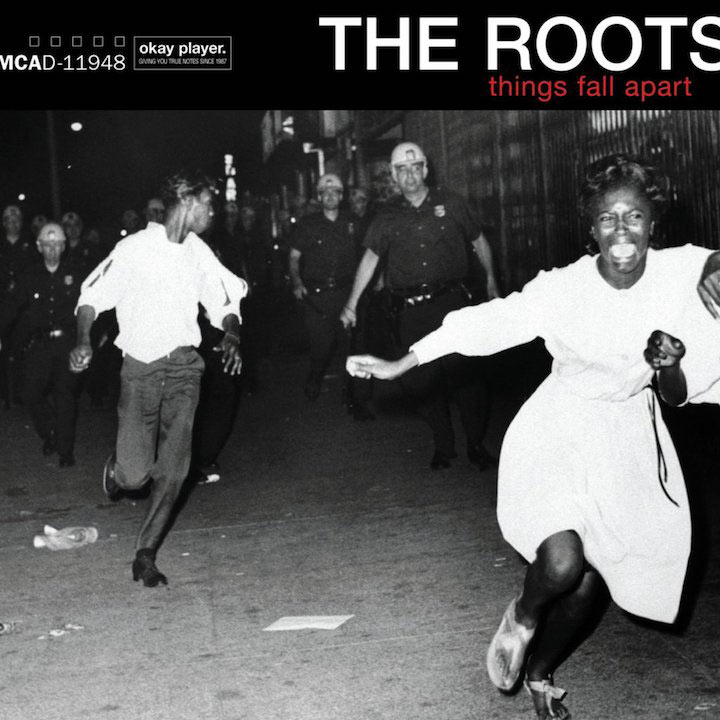
At the dawn of the Millennium, the majority of hip-hop album covers were not the optimal vehicle for social commentary. At the time, The Roots were withal something of an underground act, simply that was all about to change with their seminal album and provocative comprehend – or covers –for their breakthrough album. The Philly outfit released 5 limited edition album artworks featuring famous photos that depicted "visual failure in society", from a murdered mafia boss to a burning church, a infant crying amid the rubble in Shanghai after WWII to the 90s dearth in Somalia, and, most famously, ii women being chased by police force during the 60s riots in the Bed-Stuy neighborhood in Brooklyn. While most of The Roots' previous covers just depicted the band, Things Fall Apart was a pace towards social activism both in their music and imagery.
Blink-182: Enema Of The State (1999)
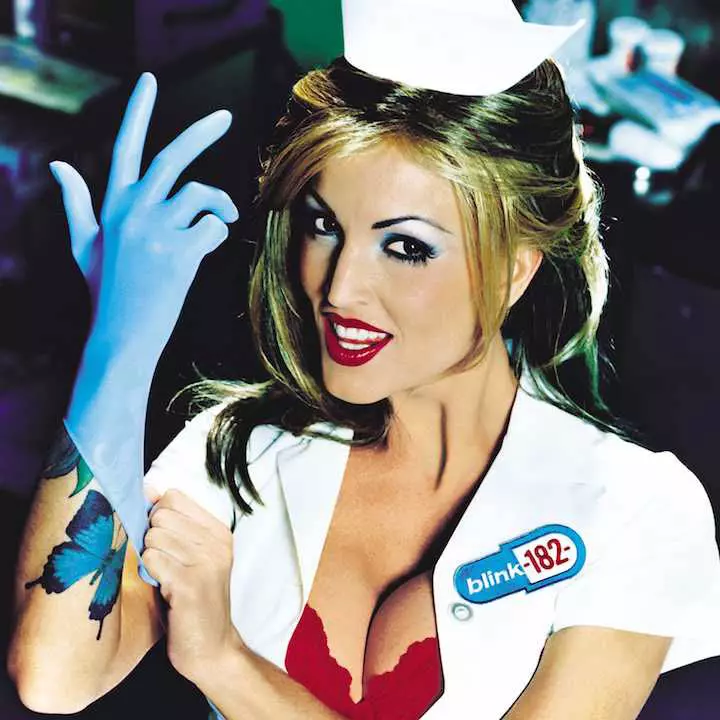
Every bit the face up of the pop-punk explosion, Blink-182 knew their audition well and catered to it accordingly with their explicit cover to their 1999 striking album Enema Of The State – much to the delight of their prepubescent male fans. Adult extra and exotic dancer Janine Lindemulder posed as a nurse for the encompass, much to the chagrin of the American Red Cross, who demanded the ring remove their logo from the artwork, every bit it was a "violation of the Geneva Convention". Lindemulder would reprise her nurse role in the ring's video for 'What'south My Historic period Once again', thanks to music turned porn publicist Brian Gross. The cover and accompanying video fabricated Blink-182 famous and brought the adult manufacture to centre America.
The Strokes: Is This It (2001)
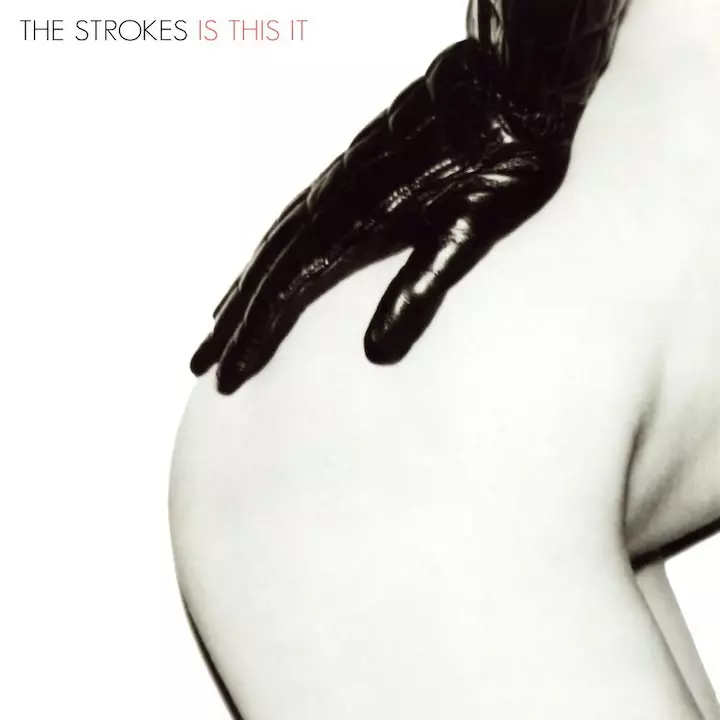
Hailed as the leaders of the "neat-rock-revival", The Strokes' subscribed to the age-onetime model of "sex activity sells" for their S&Grand-inspired cover. A mix of Helmut Newton fashion photography and Spinal Tap's Smell The Glove, the evocative cover was shot by photographer Colin Lane, who used his girlfriend every bit the model and a leftover prop to create the stark epitome. When it came to selling the album in u.s.a., yet, stores weren't having it, and the cover was inverse to a close-upward image of subatomic particle tracks in a bubble chamber. Chalk this one upwardly as another win for puritanical America.
Amy Winehouse: Back To Blackness (2006)

As an artist whose personal image is inseparable from her music, it was but fitting that the promising young vocaliser should grace her own album embrace. Back To Blackness would be her introduction to America and the rest of the world, and much had changed since her UK debut, Frank. With her cascading hair, sleeve tattoos, and rockabilly makeup, even merely sitting in a chair appeared equally an act of disobedience, albeit with a hint of vulnerability, with her hands tucked betwixt her legs. This indelible paradigm would come to define Amy Winehouse's legacy and inspired countless young girls to adopt her daughter-group-fellow member-gone-bad fashion.
Katy Perry: Teenage Dream (2010)
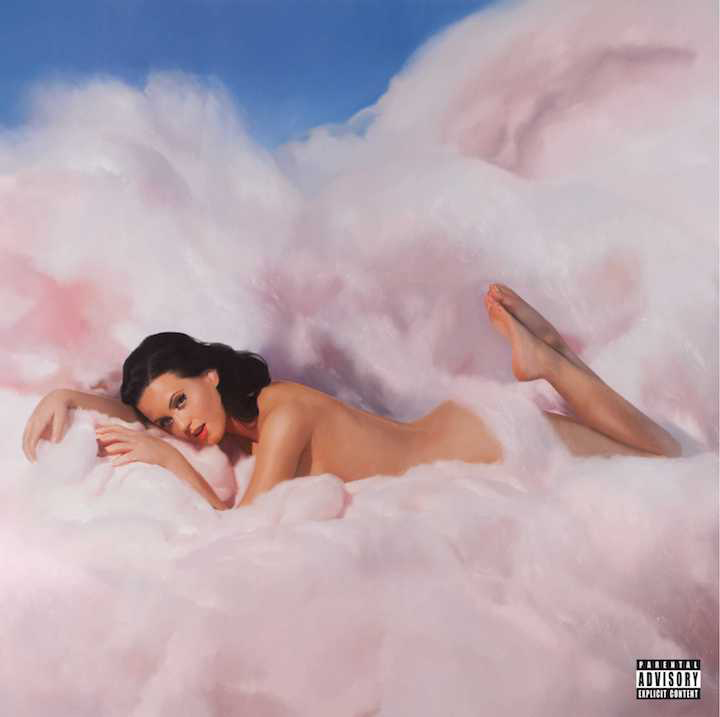
In popular music, in that location's no shortage of scantily-clad women on anthology covers, but it's unremarkably the domain of male musicians. Always one for pushing the envelope using her ain image, Katy Perry teamed up with Los Angeles-based creative person Will Cotton wool to create her ain pin-up artwork for the cover of her hit album, Teenage Dream . The result was the cartoonish sensuality of Fine art Frahm meets Candyland camp, and it has shaped Perry'south Technicolor universe ever since. Cotton wool was also the creative director for Perry'south 'California Gurls' video, which established Perry'due south signature trademark of tongue-in-cheek sex entreatment.
Discover the nearly controversial album covers of all fourth dimension.
Source: https://www.udiscovermusic.com/stories/25-iconic-album-covers/
0 Response to "Icanvas the Music Hall Gallery Wrapped Canvas Art Print by Eric Fan"
Post a Comment